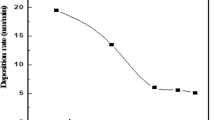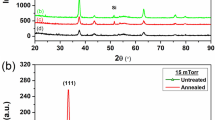Abstract
Thin films of NiO (bunsenite) with (200) preferential orientation were synthesized on glass substrates by direct current sputtering technique in Ar+O2 atmosphere. Nanostructural properties of the NiO films were investigated by X-ray diffraction and also by atomic force microscopic (AFM) studies. Electrical and optical properties of the deposited films were investigated as a function of different partial pressure of oxygen in the sputtering gas mixture during deposition. The films showed p-type electrical conduction and the conductivity depends on the partial pressure of oxygen. The electrical conductivity (σRT) was found to be .0615 S cm−1 for films deposited with 100% O2 and its value sharply decreased with the decrease the partial pressure of O2; for example σRT for 50% O2 was 6.139 × 10−5 S cm-1. The mechanism of the origin of p-type electrical conductivity in the NiO film is discussed from the viewpoint of nickel or oxygen vacancies, which generate holes and electrons respectively. X-ray photoelectron spectroscopic studies supported the above argument. Corresponding optical properties showed that the transparency decreases with increasing oxygen partial pressure and the bandgap also decreases.









Similar content being viewed by others
References
Swagten HJM, Strijkers GJ, Bloemen PJH, Willekens MMH, De Jonge WJM (1996) Phys Rev B 53:1039
Carey MJ, Berkowitz AE (1993) J Appl Phys 73:6892
Soeya S, Hoshiya H, Meguro K, Fukui H (1997) Appl Phys Lett 71:3424
Hwang DG, Lee SS, Park CM (1998) Appl Phys Lett 72:2162
Koide S (1965) J Phys Soc Jpn 20:123
Hotovy I, Huran J, Siciliano P, Capone S, Spiess L, Rehacek V (2001) Sens Actuators B Chem 78:126
Kumagai H, Matsumoto M, Toyoda K, Obara M (1996) J Mater Sci Lett 15:108
Kitao M, Izawa K, Urabe K, Komatsu T, Kuwano S, Yam S (1994) Jpn J Appl Phys 33:6656
Chan IM, Hsu TY, Hong FC (2002) Appl Phys Lett 81:1899
Nishizawa S, Tsurumi T, Hyodo H, Ishibashi Y, Ohashi N, Yamane M, Fukunaga O (1997) Thin Solid Films 302:133
Yu GH, Zeng LR, Zhu FW, Chai CL, Lai WY (2001) J Appl Phys 90:4039
Otterman CR, Temmink A, Bange K (1990) Thin Solid Films 193–194:409
Manago T, Ono T, Miyajima H, Yamaguchi I, Kawaguchi K, Sohma M (2000) Thin Solid Films 374:21
Jiao Z, Wu MG, Qin Z, Xu H (2003) Nanotechnology 14:458
Chen X, Wu NJ, Smith L, Ignatiev A (2004) Appl Phys Lett 84:14
Terakura K, Williams AR, Oguchi T, Kübler J (1984) Phys Rev B 40:4734
Antolini E (1992) J Mater Sci 27:3335
Cox PA (1998) The electronic structure and chemistry of solids. Oxford Science Publications, Oxford. Chapter 5.3
Tuller HL (1981) In: Sørensen OT (ed) Nonstoichiometric oxides. Academic Press, San Diego, Chapter 6
Banerjee AN, Ghosh CK, Das S, Chattopadhyay KK (2005) Physica B 370:264
J.C.P.D.S. Powder Diffraction File Card 04-0850
Lee M, Seo S, Seo D, Jeong E, Yoo IK. Section j: multiferroics and graded ferroelectrics
Green DW, Reedy GT, Kay JG (1979) J Mol Spectrosc 78:257
Bauschlicher CW Jr, Nelin CJ, Bagus PS (1985) J Chem Phys 82:3265
Walch SP, Goddard WA III (1978) J Am Chem Soc 100:1338
Bauschlicher CW Jr (1985) Chem Phys 93:399
Friedman-Hill EJ, Field RW (1992) J Mol Spectrosc 155:259
Bauschlicher CW Jr, Maitre P (1995) Theor Chim Acta 90:189
Vicki DM, Jarrold CC (1998) J Chem Phys 108(5):1804
Kofstad P (1972) Non-stoichiometry, diffusion, and electrical conductivity in binarymetal oxidex. Wiley, New York, p 252
Kofstad P (1972) Non-stoichiometry, diffusion, and electrical conductivity in binary metal oxidex. Wiley, New York, p 44
Kingery WD, Bowen HK, Ulhmann DL (1976) Introduction to ceramic, 2nd edn. Wiley, New York, p 899
Rees ALG (1954) Chemistry of the defect solid state. John Wiley and sons Inc., New York
Fogler HS (1992) Elements of chemical reaction engineering, 2nd edn. Prentice-Hall, New York, p 254
Dirksen JA, Duval K, Ring TA (2001) Sens Actuators B 80:106
Dummer GWA (1970) Materials for conductive and resistive function. Hayden Book Company Inc., New York
Walter JM (1967) Seven solid states. Benjamin, New York
Wanger CD, Riggs WM, Davis LE, Moulder JF (1979) Handbook of X-ray photoelectron spectroscopy. PHI, Eden Prairie, Minnesota
Lu YM, Hwang WS, Yang JS, Chuang HC (2002) Thin Solid Films 420–421:54
Pankove JI (1971) Optical process in semiconductors. Prentice Hall, Inc., New Jersey, p 34
Acknowledgements
The authors wish to thank Department of Science and Technology (DST), Govt. of India for financial support. The authors also wish to thank the University Grants Commission (UGC), Govt. of India, for providing some characterizational facilities under the ‘University with potential for Excellence’ scheme during the execution of the work. One of (BS) also wishes to thank UGC for awarding a junior research fellowship (JRF) during the execution of the work.
Author information
Authors and Affiliations
Corresponding author
Rights and permissions
About this article
Cite this article
Nandy, S., Saha, B., Mitra, M.K. et al. Effect of oxygen partial pressure on the electrical and optical properties of highly (200) oriented p-type Ni1−xO films by DC sputtering. J Mater Sci 42, 5766–5772 (2007). https://doi.org/10.1007/s10853-006-1153-x
Received:
Accepted:
Published:
Issue Date:
DOI: https://doi.org/10.1007/s10853-006-1153-x




